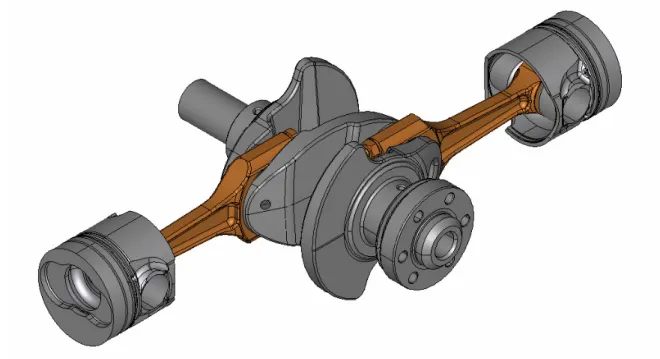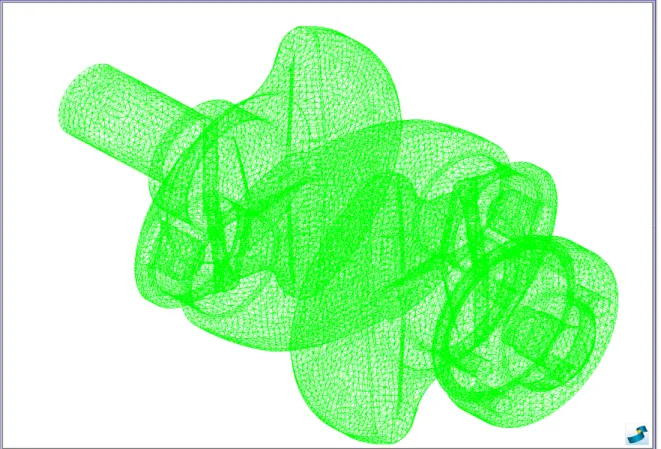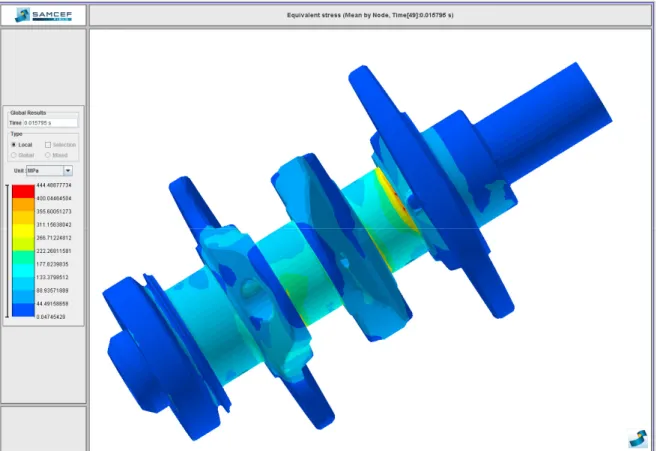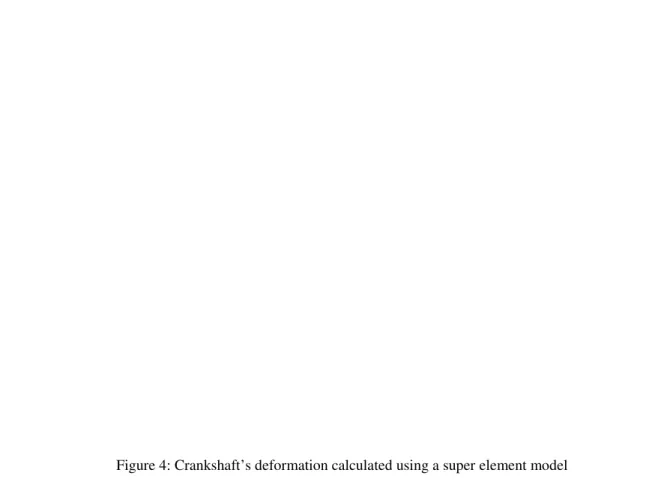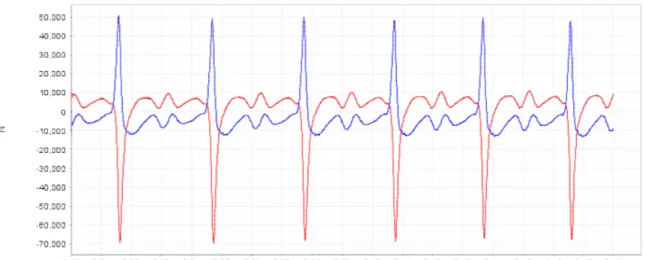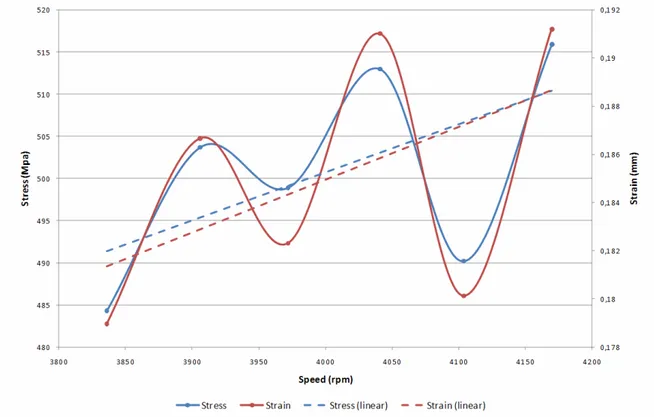1
ADVANCED ENGINE DYNAMICS USING MBS AND SUPER
ELEMENT APPROACH: APPLICATION TO TWIN-CYLINDER
BOXER ENGINES
Yannick Louvigny* and Pierre Duysinx* *
LTAS – Automotive Engineering - University of Liège, B52, Chemin des Chevreuils 1, B-4000 Liège, Belgium e-mail : yannick.louvigny@ulg.ac.be, p.duysinx@ulg.ac.be
Keywords : Flexible multibody dynamics, Super element, Engine dynamics
Abstracts. Dynamic simulations of a twin-cylinder boxer engine have been carried out with
rigid and flexible multibody models using the finite element approach in SAMCEF FIELD MECANO Software. The CAD drawing of the two pistons, two connecting rods and crankshaft were imported in the SAMCEF FIELD environment and the parts were linked together using appropriate kinematic joints. Rigid (all components are rigid) dynamic simulations were realized, with an imposed constant crankshaft rotation speed as a constraint, to calculate the inertia forces and moments in the engine. Then the forces due to the gas pressure were added in the simulation to calculate more precisely the load applied on engine parts. A mixed model was developed (pistons and connecting rods are considered as rigid bodies while the crankshaft is modeled with flexible elements and meshed). With this model, calculation of crankshaft stresses and displacements was possible. For constant speed studies, flexible simulations were carried out on one or two engine cycles but simulations with a variable rotation speed had to be carried out on a larger number of engine revolutions. Due to the complex shape of the crankshaft, the simulation time became important and it was difficult to keep on working with the fully detailed crankshaft geometry. So, simplified models of the crankshaft were developed and compared: 1/ a tridimensional model with simplified geometry (no fillet radius, no lubrication hole…), 2/ a beam model and 3/ a super element model.. In this work, the super element model of the crankshaft allows important reductions of CPU time, which was the main purpose of the method. But it offers other advantages with respect to the complex model: 1/ if one is not interested in determining all the values of strains and stresses but only at a given instant, it is possible to recover only a small number of results, which will also reduce computing time; 2/ this approach enables also a direct decoupling of the displacement coming from the deformation and from the rotation.
2 1 INTRODUCTION
Facing environmental challenges, automotive industry has to improve the fuel economy of new vehicles and to reduce their polluting emissions. To make cleaner car, a strategy that is widely used nowadays is the downsizing. In this context, small twin-cylinder engines regain interest for use in urban cars or as prime movers in hybrid electric cars. A previous study Ref. [4] has pointed out the advantages of the boxer engine configuration (flat engine with opposed cylinders). However, for non-classical engine configurations, one has not a deep understanding of their loading and their vibration behavior so that there is a need for advanced modeling and simulation tools of engine dynamics. Thus engine dynamics simulation has become an issue to design mechanical components and to reduce the development cost of new propulsion systems.
2 CONSTANT SPEED SIMULATIONS 2.1 Rigid multibody model
In previous works Ref. [5, 8], dynamic simulations of a twin-cylinder boxer engine have been carried out with rigid and flexible multibody models using the finite element approach Ref. [1] implemented in SAMCEF FIELD MECANO software. First, simulations of the engine running at constant revolution speed (4000 rpm) were carried out taking advantages of the real geometry of engine parts coming from CAD models. The CAD drawing of the two pistons, the two connecting rods and crankshaft were imported in the SAMCEF FIELD environment (Fig. 1) and the parts were linked together using appropriate kinematic joints. Rigid (all components are rigid) dynamic simulations were realized, with an imposed constant crankshaft rotation speed (a constant rotation speed of 4000 rpm is prescribed as a kinematic constraint at the flywheel area), to calculate the inertia forces and moments in the engine. Then the forces due to the gas pressure were added in the simulation to calculate more precisely the load applied on engine parts.
3 2.2 Flexible multibody model
A mixed model is developed (pistons and connecting rods are considered as rigid bodies while the crankshaft is modeled with flexible elements and meshed) and constraints are still the prescribed rotation speed of 4000 rpm and the pressure acting on the two pistons. With this model, calculation of crankshaft stresses and displacements is possible. A major problem is to make a proper modeling of the various contact surfaces of the crankshaft since those bearing surfaces are in fact hydrodynamic bearings. The first simulation uses a “rigid hinge” model for the connecting rod crankshaft contacts and for the crankshaft main journals. The rigid hinge allows no translation between the two components, only a degree of freedom in rotation is permitted. The time integration algorithm used for the simulation is the Chung-Hulbert algorithm. Results from the simulation (moments, forces, strains, stresses…) are saved every 400 µs (it corresponds to a crankshaft rotation angle of 10 degrees) except when the crankshaft’s stresses are very high. In this case, the results are saved every 5 µs.
The crankshaft is meshed with linear tetrahedrons. Its complex shape imposes to use small elements (characteristic length of an element is 3 mm) so that the complete crankshaft mesh is composed of 283700 elements (Fig. 2). Using refined mesh in a multibody simulation requires a large CPU time (approximately 13 hours on a quad-core 2.8 GHz computer) and computing resources (8 Gb of RAM).
Figure 2: Crankshaft’s mesh (283700 linear tetrahedrons)
Fig. 3 illustrates the crankshaft stresses for the bearing surfaces using a “rigid hinge” model. The maximum stress value is 444.8 MPa (Von Mises criterion, mean value by node ) occurs at time 15.78 ms that corresponds to a crankshaft angular position of 18.7 degrees after the top dead center (this means between the radial and tangential maximum force). The maximum stress is located in the crankpin connected to the piston opposed to the flywheel
4
when it is submitted to the maximum gas pressure. Other important stresses are located in the other crankpin.
Figure 3: Crankshaft’s stresses
The “rigid hinge” model was the first and simplest model developed for the bearing surfaces. Other models for the connecting rod/crankshaft contacts and for the crankshaft main journals were developed because these contacts appear to be critical points of the engine dynamic simulations. Two models use “flexible-rigid contacts”. They allow simulating or not a running clearance. Another model uses “radial bushings” that are similar to the “flexible-rigid contacts” but they have a radial stiffness to slow down the translational motion of the crankshaft in the bore. The radial stiffness is used to approximate the effect of an oil film. The last bearing model is the “hydrodynamic bearing model” implemented in SAMCEF FIELD MECANO. This model simulates the oil film behaviour by solving the Reynolds equation. A more complete description of these four models is given in Ref. [5, 8].
3 VARIABLE SPEED SIMULATIONS 3.1 Simplified crankshaft models
In a second step, revolution speed variation is considered to investigate engine unsteady states. For constant speed studies, flexible simulations were carried out on one or two engine cycles but simulations with a variable rotation speed have to be carried out on a larger number of engine revolutions. Due to the complex shape of the crankshaft, the simulation time becomes important and it is difficult to keep on working with the fully detailed crankshaft geometry. So, simplified models of the crankshaft are developed and compared: 1/ a tridimensional model with simplified geometry (no fillet radius, no lubrication hole…) Ref.
5
[6], 2/ a beam model Ref. [6] and 3/ a super element model. These models are first validated with results of constant speed flexible simulations. Then engine simulations with a variable rotation speed are made using different flexible crankshaft models to assess the best compromise between results accuracy and computing time.
3.2 Super element crankshaft model
The super element approach is a substructure technique used to reduce the size of a problem Ref. [2, 3]. It can be used as well in static and dynamic analysis and required three steps. The first one is the condensation step, some DOF are eliminated to reduce the size of the stiffness and mass matrices. Indeed, the dynamic behaviour of one subsystem can be fully described by boundary DOF and its natural frequencies Ref. [7, 9]. Once the super element is created, it has to be assembled in the global system that can then be solved, it is the second step. Finally, some specific results of the super element, for instance the strains as in Fig. 4 and stresses as in Fig. 5, can be recovered by a dynamic analysis of the super element. In this work, the super element model of the crankshaft enables important reductions of CPU time, which was the main purpose of the method. But it offers other advantages with respect to the complex model: 1/ if one is not interested in determining all the values of strains and stresses but only at a given instant, it is possible to recover only a small number of results, which also reduces the computing time; 2/ this approach permits also a direct decoupling of the displacement coming from the deformation and from the rotation.
A dynamic simulation of the engine calculated using the super element technique is performed. A super element of the crankshaft is created using the same mesh as the full model (characteristic length of a tetrahedral element is 3 mm). The super element is incorporated in the engine model and the calculation is carried out with the same constraint (rotation speed of 4000 rpm and the pressure acting on the two pistons). Using the super element in the multibody simulation reduces the required CPU time (approximately 3.25 hours on the same computer instead of 13 hours) and computing resources (3 Gb of RAM instead o 8 Gb). The predicted maximum stress (438.1 MPa) occurs at time 15.78 ms and is located in the crankpin connected to the piston opposed to the flywheel (Fig. 5). This stresses distribution is similar to the one obtained with the crankshaft full model (Fig. 3) and the maximum value relative error is 1.5%. Moreover, during the super element recovery step, the crankshaft’s strains can easily be calculated (Fig. 4), which is more difficult with the simulation using the full model because the displacements due to the deformation are not separable with the displacements coming from the motion. The maximum strain occurs at 15.78 ms which is exactly the time when the stresses are also maximum. The maximum deflection value is 0.23 mm and is located in the counterweight linked to the crankpin where the gas pressure is acting. This reflects the twisting of the crankshaft which is maximum when the gas pressure is applied to the piston located the farthest from the flywheel.
6
Figure 4: Crankshaft’s deformation calculated using a super element model
7 3.3 Variable speed simulation using super element
To evaluate the effect of speed variation on the crankshaft strains and stresses, a super element model of the crankshaft is used in a variable speed engine simulation. This simulation is similar to the constant speed one, except that the prescribed rotation speed varies, in this case, from 3800 rpm to 4200 rpm in 0.18 seconds and the force due to the gas pressure that has been adapted to remain in phase with the crankshaft rotation.
Figure 6 shows the forces that are transmitted from one connecting rod to the crankshaft during the operation of the engine. The radial force (blue curve) reaches a maximum value of 50600 N and the maximal tangential force (red curve) 69.200 N. The maximal value of the peak forces (radial and tangential) decreases at each rotation because the inertia force is increasing and is opposed to the force generated by the gas pressure when the engine speed is increasing.
Figure 6: Forces acting on one crankpin
The main effect of the speed variation is the variation of inertia forces. When the speed is increasing, the inertia force generated by the pistons and connecting rods increases also. Since this force is opposed to the gas pressure force, the total force coming from the connecting rods and acting on the crankpins is reduced. Thus, the crankshaft’s stresses tend to decrease. On the other hand, the inertia force due to the crankshaft is also increasing and that leads to an inflation of crankshaft’s strains and stresses. Finally, the maximum values of strains and stresses calculated in the crankshaft are slightly increasing when engine speed is rising. Fig. 7 shows the maximum values, occurring always at the same engine position, of crankshaft’s strains and stresses for several engine cycles. The red and blue solid lines represent the calculated values of strains and stresses while the dashed lines are trend lines of those values.
8
Figure 7: variation of maximum strains and stresses with rotation speed
4 CONCLUSION
The rigid multibody simulation enables quick calculations of inertia forces and moments inside the engine. Moreover, the forces acting on each component can also be computed as soon as the effect of the gas pressure is taken into account. The flexible multibody dynamic simulation allows carrying out strain and stress analysis during the complete revolution of the engine. But working with the full model requires a large CPU time and computing resources, so simplified models, in particular super element models, are useful to calculate strains and stresses with a drastic reduction of computing time.
9 REFERENCES
[1] M. Geradin and A. Cardona. Flexible multibody dynamics: a finite element approach. John Wiley, 2000.
[2] Y. He, X. Zhou and P. Hou. Combined method of super element and substructure for analysis of ILTDBS reticulated mega-structure with single layer latticed shell substructures. Finite Elements in Analysis and Design, 46, 563-570, 2010.
[3] S. S. Law, T. H. T. Chan and D. Wu. Super-element with semi-rigid joints in model updating. Journal of Sound and Vibration, 239, 19-39, 2001.
[4] Y. Louvigny. Preliminary design of twin-cylinder engines (DEA thesis). Université de Liège, 2008.
[5] Y. Louvigny, N. Vanoverschelde, G. Janssen, E. Breuer and P. Duysinx. Dynamic analysis and preliminary design of twin-cylinder engines for clean propulsion system. Proceedings of the ECCOMAS Thematic Conference in Multibody Dynamics, 2009. [6] Y. Louvigny and P. Duysinx. Advanced engine dynamics using MBS: Application to
twin-cylinder boxer engines. Proceedings of the 1st Joint International Conference on Multibody System Dynamics, 2010.
[7] Z.Q. Qu. Model order reduction techniques: with applications in finite element analysis. Springer, 2004.
[8] N. Vanoverschelde. Etude de la dynamique d’un groupe motopropulseur deux cylindres
à plat (Master thesis). Université de Liège, 2008.
[9] X. Zhang and S. D. Yu. Torsional vibration of Crankshaft in an engine propeller nonlinear dynamical system. Journal of Sound and Vibration, 319, 491-514, 2009.
